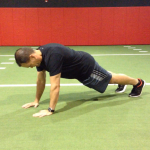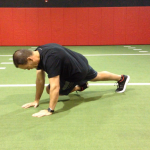Brian Schiff’s Blog
Injury Prevention, Sports Rehab & Performance Training Expert
Improving rotational strength and stability in the torso, shoulders and hips is important for injury prevention and performance. The ability to resist and control rotational loads can reduce stress on the body during transverse plane activities and deceleration during sport. This exercise will demonstrate how to train rotational stability in an unstable manner using water with the Aktiv AQUA Bag. The video below is my latest online column for PFP Magazine.
The water provides an unstable training environment that is effective for beginners and advanced users. You can read the entire online column by clicking here.
It is that time of the year again. Everyone wants to lose weight and trim their waistlines. Abs, abs and more abs, right? I am all about some core training, but I am always concerned with some of the ab variations that I see commonly used at the gym and in group fitness environments.
Many exercise enthusiasts have tight hip flexors and poor abdominal control. Sprinkle in a history of low back pain or a prior disc injury along with straight leg abdominal exercises and now you have the perfect recipe for a possible back injury. Why is that? Well, the psoas originates from the lumbar spine and attaches to the lesser trochanter on the hip.
In the picture above, you can see how the muscle impacts the spine and hips. As you lower your legs toward the ground during an ab exercise, there is a reverse muscle action that takes place and resultant anterior shear force exerted on the lumbar spine. When the abdominal muscles cannot resist this motion, the lumbar spine hyperextends.
Many people will even report feeling a pop in the front of the hip while doing scissor kicks, leg lowering or throw downs. In many cases, this may be the tendon running/rubbing on the pectineal eminence. Unfortunately, long lever and/or ballistic abdominal exercises with inherently poor core stability/strength, fatigue and gravity working against you will create significant load and strain on the lumber spine. Ever wonder why you wanted to put your hands under your back while doing 6 inches? Your brain is trying to flatten the spine using your hands as it knows the hyperlordotic position is uncomfortable and threatening.
In light of this, I put together a little video for PFP Magazine revealing a safer way to work your abs and prevent undue stress and strain on your back. Check it out below.
Keep these modifications and progressions in mind the next time you hit the gym or a boot camp class focusing on core/ab training.
Improving lateral chain strength is always a priority when training or rehabbing athletes. Improving anti-rotation stability is particularly important for injury prevention and dissipation of forces in the transverse plane. Whether working with a post-op ACL client or training an overhead athlete, I am always seeking ways to increase torso/pillar stability to increase efficiency of movement and reduce injury risk.
This video below from my Functionally Fit series for PFP Magazine will demonstrate a great exercise do accomplish these training goals.
Emphasis should always be placed on maintaining alignment. Do not progress the load too quickly, and be cautious if using the fully extended down arm position if clients have a history of shoulder instability or active shoulder pathology as this places more stress on the glenohumeral joint. Below are some progressions and regressions as well:
Regressions
1. Decrease the hold time as needed to maintain form and alignment
2. Allow the kettlebell to rest against the right dorsal wrist/forearm
3. Stack the top foot in front of the other foot as opposed to stacking them on top of one another to increase stability
4. Bend the knees to 90 degrees to reduce the body’s lever arm
Progressions
1. Increase the weight of the kettlebell and/or increase hold time
2. Lift the top leg away from the down leg
3. Add light perturbations to the top arm during the exercise to disrupt balance and challenge stability
4. Perform the exercise with the down arm fully extended
Increasing shoulder, torso and hip strength and stability is a common training goal for athletes involved in sport. Facilitating hip disassociation and kinetic chain linking with exercise is always a plus. I like to use a diagonal mountain climber with hip extension to accomplish these objectives. More specifically, I utilize this exercise with my overhead athletes and anyone involved in cutting, pivoting and rotational sports.
Begin in a tall plank position. The hands should be beneath the shoulders with the feet on the floor and shoulder width apart. Slowly bring the left knee/hip under the body and toward the right elbow. Pause at the end point prior to losing form or control.
Next, return the left leg toward the start position and up into full hip extension in one continuous movement. Pause at the top end of available hip extension and repeat the cycle for 10 repetitions or time on the same leg. Alternate legs and perform 2-3 sets on each side.
Sufficient upper body strength and core/hip stability in a 3 point position is necessary to perform the exercise correctly. At no time should the foot of the moving leg touch the floor or be used to balance the body. As far as a pace, I feel using a 1/1/1/1 cadence works best.
This exercise is an excellent way to promote shoulder, core and hip stability while facilitating hip disassociation as well. Driving the hip back up into extension will activate the gluteals and simultaneously force the stable (fixed) hip to stabilize the pelvis and counterbalance the movement pattern. In addition, the client will have to effectively activate the hip and abdominal musculature throughout to avoid unwanted pelvic tilt/rotation during the movement.
Click here to view the full video of this exercise I did for my ‘Functionally Fit’ column for PFP Magazine.
I like to include exercises on this blog that are useful for rehab and fitness professionals as well as fitness enthusiasts who visit. This is a cool exercise that a colleague taught me. I also recently shared this as part of my ‘Functionally Fit’ column for PFP Magazine. It works great when doing partner workouts or if coaching a client. We used it during our off season training for the Carolina Hurricanes and it is much harder than it looks on the surface.
Training clients to maintain core stiffness in athletic functional positions will improve performance and reduce injury risks for the spine and lower extremities. This exercise is an effective way to address postural stability, increase core strength and enhance kinetic chain proprioception

Execution
Begin in a split squat position holding a stability ball overhead. The client maintains an isometric split squat while the coach/trainer provides directional perturbations in an attempt to disrupt balance and stability.
You may opt for several quick rhythmic perturbations or elect to use more sustained pushes (1-2 seconds in each direction) to challenge the client. Allow the client to reset to the desired position if he/she does lose balance in order to facilitate optimal motor patterning. Perform 30 seconds with the left leg forward, rest 30 seconds and then repeat with the right leg forward. Complete two sets on each side.
Be sure to observe asymmetries or deviations specific to either side as this will allow for better cuing and reveal energy leaks. Marking the desired distance between the front heel and rear foot toes with tape will ensure consistency for each trial side-to-side.





